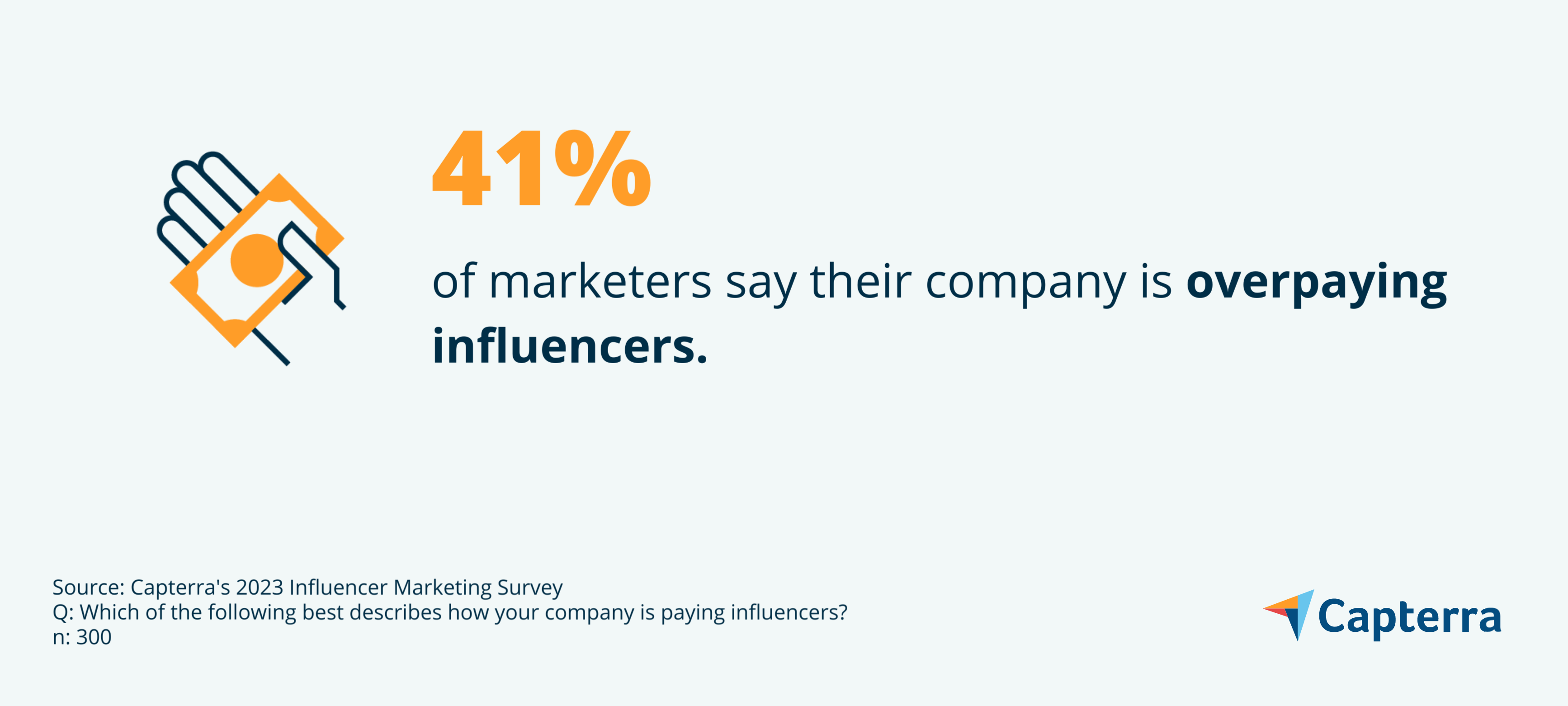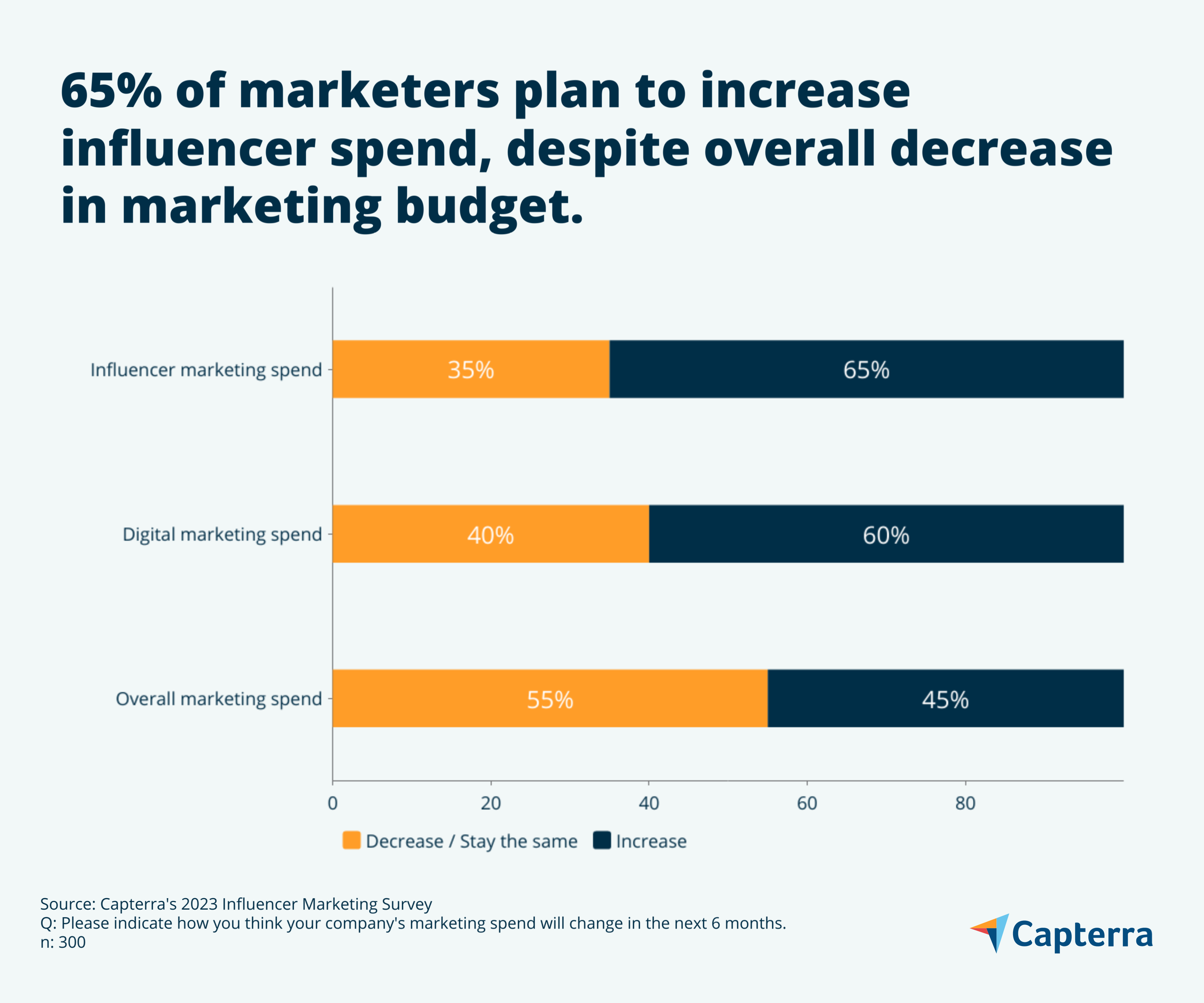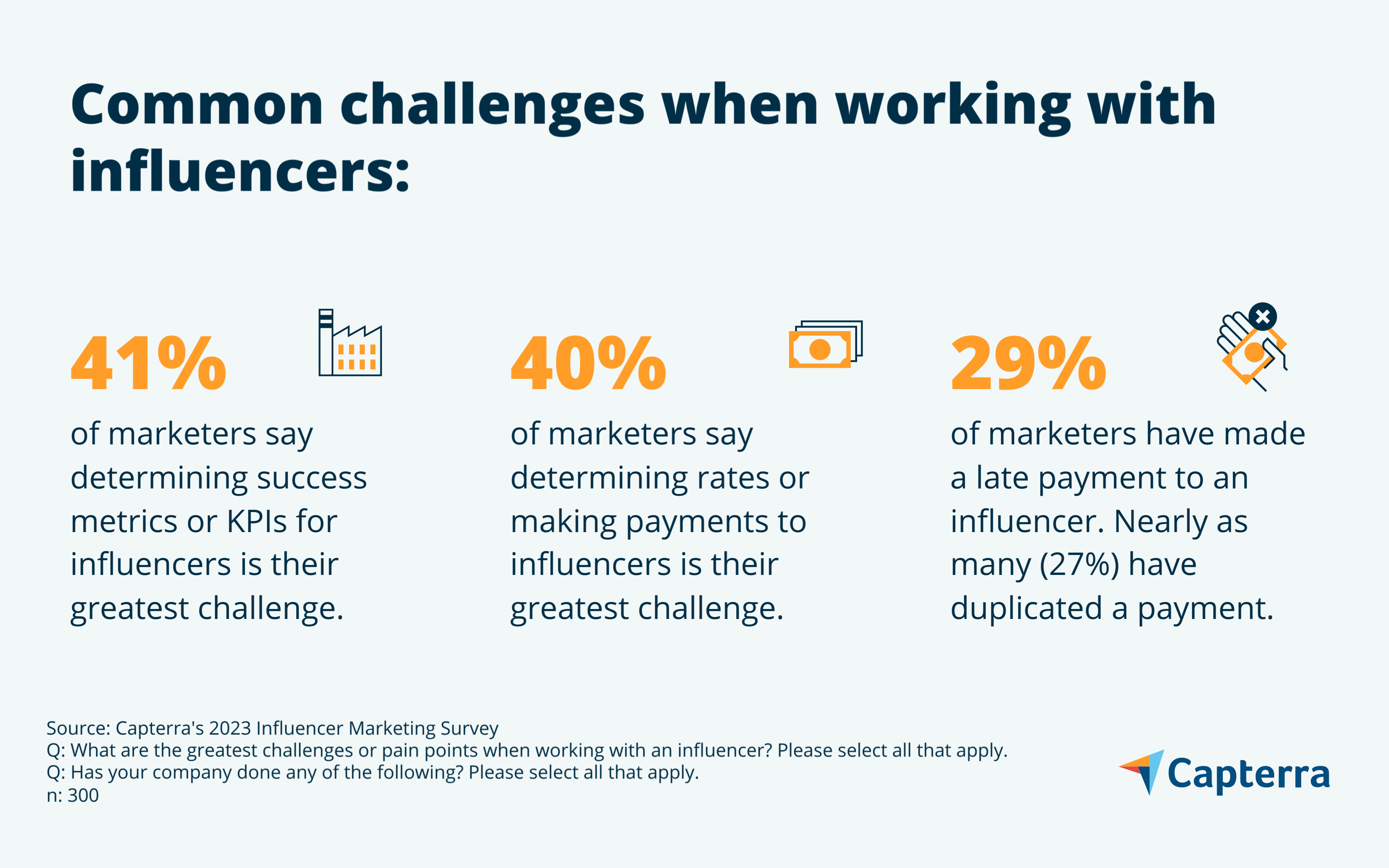2 in 5 marketers are challenged by influencer payments—learn what actions can help.
In a world inundated with marketing and advertising messages, hiring influencers can help brands differentiate themselves and stand out as authentic, especially with more and more audience time going to social platforms. Working with influencers can further increase your brand’s reach, help you connect with customers, and build stronger or more personal relationships with your target audience.
However, payments are a particularly nebulous aspect of influencer marketing. In fact, according to Capterra’s 2023 Influencer Marketing Survey* among 300 marketing professionals that currently use influencers for marketing or advertising initiatives, 40% say making payments is particularly difficult.
With rates varying widely depending on the type of influencer, engagement, number of followers and so on, many marketers struggle with budgeting and determining how or how much to pay in these partnerships. Unfortunately, only half of survey respondents say they feel confident pricing influencers.

In this report, we’ll explore our survey results to identify some of the most common payment issues companies face when working with influencers and how they can be overcome. With these findings, you’ll be able to create an informed payment strategy for your company in 2023.
/ Key findings
Paying influencers is a significant challenge for many companies: 40% of marketers say the greatest pain point they have when working with influencers is determining rates or making payments. 29% of marketers say they have made a late payment, while 27% have even duplicated a payment.
Pay per performance is gaining traction: 56% of marketers say they are turning to performance-based metrics when it comes to paying influencers.
Legal review is common for many companies that work with influencers: Security issues (44%), approving posts (37%), along with the rise of fake followers (31%) are big hurdles for marketers. 93% of marketers say their company requires review from a legal professional or team when working with influencers.
Marketers are finding success working with agencies to manage influencers: Of the 61% of marketers that say their company currently uses an influencer agency or specialist, 98% say they are satisfied with their agency’s performance.
Companies intend to increase spending on influencers and invest in longer partnerships despite decelerated overall marketing spending
Inflation and other macroeconomic considerations have many businesses worried about their budgets. However, according to our survey results overall digital marketing spending is expected to remain strong. Sixty-five percent of marketers indicate that their companies plan to increase their influencer marketing spending in the next six months despite a majority citing that they will decrease or hold steady on overall marketing spending:

Marketers continue to spend on influencers, as their investments prove to be recession-proof and worthwhile. For example, 93% of survey respondents agree that influencer marketing is extremely valuable to their company. Additionally, a whopping 98% say they are satisfied with their company’s influencer marketing initiatives.
Today many marketers are opting for long-term partnerships with influencers with 48% citing that they have set up recurring payments with individuals and 54% paying via retainer or on a continual basis.
Brand ambassador programs (where a brand and influencer work together on an ongoing basis) have also taken off in popularity demonstrating the inclination to engage in longer partnerships with influencers:

Choosing influencers comes down to reach, engagement, and relevance
Influencers can boost your brand’s reach and engagement with a target audience you might not otherwise be able to access. According to our research, marketers report that some of the greatest advantages of working with influencers are to build trust or credibility (65%), create content (64%), increase engagement (62%), and increase brand or product awareness (61%).
Our survey highlights a few key factors when choosing influencers:
Number of followers: 54% of marketers say that the number of followers an influencer has is very important when considering hiring. A high number of followers can be an indicator of good content creation.
Engagement: Marketers are increasingly opting to work with mid-tier influencers who although have a smaller following (50,000 to fewer than 500,000), can tap into highly targeted and engaged audiences. For example, 69% of marketers say they typically hire mid-tier influencers.
Aesthetic: Marketers say that fitting a certain aesthetic is equally important (54%) as an influencer’s number of followers when hiring. This suggests that influencers are hired depending on a company’s unique goals and the influencer’s specific strengths and following.
Platforms: Incorporating more than one partnership to create content or using multiple social platforms is also a standard practice among marketers. Eighty-six percent of survey respondents state that their company works with between 11 to 30 influencers. The majority distribute content via YouTube (94%), Facebook (89%), Instagram (88%), Twitter (82%), and TikTok (79%).
If you would like to learn more about selecting the right influencer or campaign type, below are a few important questions to consider[1].

Now that we’ve covered how companies are investing in influencers and what they look for when selecting partners, let’s explore how much companies are currently paying influencers, what methods they use, and the typical issues they encounter when hiring.
Payment ambiguity is problematic—here’s what you can do
According to marketers surveyed, 47% say that competitive rates are very important when considering hiring an influencer. Unfortunately, there is no standard method or amount to pay influencers. That’s why negotiating the terms of payment or the payment process is an important part of any influencer marketing collaboration.

Keep in mind that influencers themselves have a significant say when establishing a payment method. For example, 90% of marketers say it is extremely common for influencers to help determine their company’s payment method. The most common form of payment in our survey is pay per campaign:

Just as in selecting the right influencer, reach, engagement, and relevance ultimately factor into determining influencer rates. Influencer rates are often based on engagement and number of followers. Yet, there are other factors that can affect prices, like industry/niche, content quality, agency fees, and performance metrics. If you are new to investing, you can expect that rates will fluctuate.
The majority of marketers in our survey pay over $1,000 per post. Among the 50% of survey respondents that say they pay per post, the majority (51%) pay between $1,001 and $5,000. Another 40% of respondents say they pay between $5,001 and $10,000.
Marketers are basing compensation on performance
Among the 41% of marketers that feel their company is overpaying influencers, 49% say the greatest challenge they have is achieving a clear ROI or promised results.
These days, 56% of marketers say they are turning to performance-based metrics when it comes to paying influencers. With pay per performance, influencers are compensated based on specific actions, such as sales, clicks, and impressions. As desired outcomes will vary using this method, companies need to be very clear and transparent about the goals and metrics they want to achieve.
Pay per performance is becoming more popular for a few reasons: for starters, it is more comfortable for small to midsize businesses to only pay for specific outcomes in order to avoid wasting money or additional risk. Pay per performance also helps incentivize influencers to deliver results when they can explicitly understand and track their goals. Lastly, advances in the ability to track and collect marketing analytics have made measuring performance much easier over time.
According to research from Gartner, influencer marketing metrics fall into three categories: strategic, operational, and tactical[1]. Consider the common metrics below to help you clearly define your goals that will in turn make working with influencers much easier:
#1. Business and strategic sample metrics
Revenue growth
New project sales
Brand health
Profitability
Market share
Customer acquisition
#2. Operational sample metrics
Number of influencers/posts
Inbound links
Referral traffic, SEO improvement or mentions
Sentiment
Lead generation
#3. Business and strategic sample metrics
Awareness (e.g., views, share of voice, impressions or earned media value)
Engagement (e.g., likes, reactions, shares, tweets, comments)
Audience growth (e.g., incremental fans, followers or subscribers)
Conversion or other desired actions (e.g., clicks, downloads, traffic or campaign participation)
Companies can use influencer marketing software to find and manage influencers
In addition to setting clear performance metrics, the right influencer marketing software can help you connect with the most relevant influencer partners for your company and streamline the payments process.

Influencer marketing software can aid in automating payments to influencers, eliminating the need for manual invoicing and processing while diminishing the risk of errors. Companies can also easily track records and payments made.
If you’d like to learn more about the benefits, features, costs, and key considerations when considering influencer marketing software, check out our Influencer Marketing Software Buyers Guide.
Legal and agency support can help address additional challenges working with influencers
Along with payments, there are some additional challenges to keep in mind. For example, marketers say that security issues (44%), brand or reputation concerns (40%), approving posts (37%), and fraudulent or fake followers (31%) are among their greatest concerns when working with influencers.
Legal review can help flag and manage risks associated with working with influencers, including security, brand or reputation, or financial risks. Our research finds that companies are already proactive in this area—93% of marketers say their company requires review from a legal professional or team when working with influencers.
Influencer marketing campaigns are subject to the laws and regulations of the U.S. Federal Trade Commission (FTC). Companies need to stay on top of these requirements to avoid any legal issues or fines. This includes ensuring that influencer posts are clearly marked as branded and sponsored content by the influencer.
And as with any partnership, companies should have a contract or written agreement in place that documents the terms and conditions of the engagement or relationship. This will protect both parties and help ensure that the terms of the agreement are met.
Further analysis reveals that marketers are relying on agencies to streamline working relationships with influencers. These organizations offer services like strategy, matchmaking, campaign management, tracking, measurement, and more:
More than a third (34%) of marketers say they plan to use an agency or specialist specifically to work with or manage influencers in the next 12 months.
Of the 61% of marketers that say their company currently uses an influencer agency or specialist, 98% say they are satisfied with their performance.
89% of marketers would recommend using an influencer marketing agency to another company.
Interested in services to help you with your next influencer marketing initiative? Browse our digital marketing, advertising, and social media marketing agencies.
The bottom line is that hiring influencers can be a valuable part of a marketing strategy, but it does come with its own set of challenges. The numerous payment methods (e.g., pay per campaign, post, etc.) and performance standards can be particularly overwhelming. And with most companies maintaining or reducing their overall marketing spending, while increasing their spending in influencer marketing initiatives, the need to set expectations for payments is all the more essential.
Companies need to be strategic and transparent in their partnerships to ensure successful campaigns. Relying on a pay per performance payment model is one way to help you clearly define your expectations and goals when working with influencers. Companies should also consider leveraging the power of software, legal support, or agency services to help streamline and manage payments.
If like this report, check out other insights on marketing trends:

